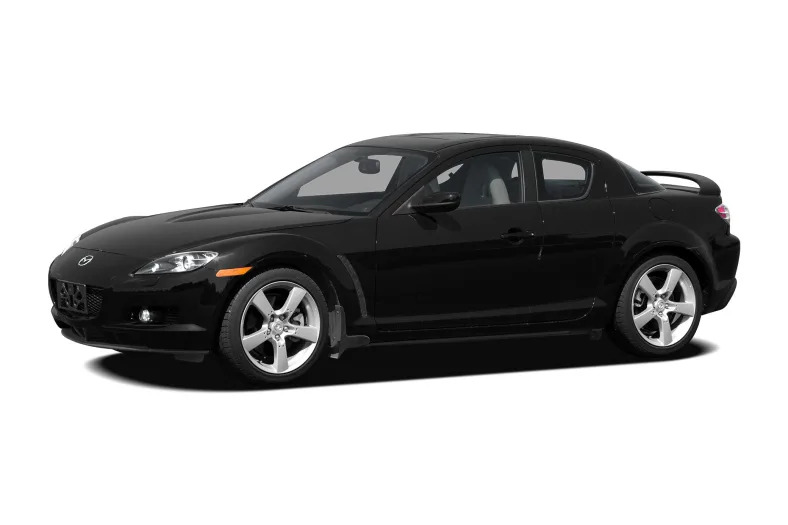Grand Touring 4dr Coupe
2008 Mazda RX-8
It's been 40 years since Mazda released its first rotary-engine production model, a twin-rotor coupe called Cosmo Sport in mid-1967. By the early 1970s, the rotary seemed poised to conquer the automotive world. That never happened for a long list of reasons, but the lightweight rotary engine found a purpose powering a delightful series of light, nimble, high-revving Mazda sports-touring cars. Over the past four decades, Mazda has manufactured more than 1.9 million rotary-engine vehicles. And we're glad it did. The latest model in this series, the ingeniously engineered Mazda RX-8, drives like a sports car, with a high-revving engine and perfect 50-50 weight distribution for balanced handling.
Yet the RX-8 is surprisingly practical. It's capable of taking the kids to soccer practice, with passenger space for four full-size adults. There's enough room for a weekend's worth of luggage or two full-size golf bags, and the small rear doors and relatively spacious trunk make trips to the home improvement center possible. It's not as roomy as a sedan, but it can move people and stuff when needed, while offer the driving experience of a two-seat sports car.
In short, the RX-8 is a true four-seat sports car. And it's the small but powerful rotary engine that makes this possible.
The RX-8 was launched as an all-new model for 2004. Its most significant update since then is the six-speed automatic transmission that arrived for 2006, replacing the previously available four-speed. In addition to two more gears, the six-speed automatic also brought steering-wheel mounted paddle controls for semi-manual shifting; and allowed the engine to be tuned closer to its manual-transmission specification, narrowing the performance gap between the auto-shifting and shift-it-yourself versions.
Still, the manual and automatic models are two different cars. The manual benefits from 232 horsepower at 8500 rpm, while the automatic gets 212 horsepower at 7500 rpm, albeit with the same 159 pound-feet of torque at 5500. The base automatic comes packaged with a softer suspension, smaller wheels and smaller brakes. The bottom line is that the manual model is for driving enthusiasts willing to sacrifice some comfort and convenience for performance. The automatic is for drivers more interested in the look and feel of a sports car than in ultimate performance and for drivers who have to contend with stop-and-go commuting.
To celebrate the 40th anniversary of Mazda's rotary engine, Mazda will offer a limited-edition 40th Anniversary RX-8, featuring Metropolitan Gray paintwork, a Cosmo Red leather interior, and unique 18-inch alloy wheels; plus suspension enhancements, fog lamps, a silver engine cover, and special badging. Look for it early in the 2008 calendar year. Otherwise, the RX-8 is unchanged for 2008.
Full Review
Full Review
The latest model in this series, the ingeniously engineered Mazda RX-8, drives like a sports car, with a high-revving engine and perfect 50-50 weight distribution for balanced handling.
Yet the RX-8 is surprisingly practical. It's capable of taking the kids to soccer practice, with passenger space for four full-size adults. There's enough room for a weekend's worth of luggage or two full-size golf bags, and the small rear doors and relatively spacious trunk make trips to the home improvement center possible. It's not as roomy as a sedan, but it can move people and stuff when needed, while offer the driving experience of a two-seat sports car.
In short, the RX-8 is a true four-seat sports car. And it's the small but powerful rotary engine that makes this possible.
The RX-8 was launched as an all-new model for 2004. Its most significant update since then is the six-speed automatic transmission that arrived for 2006, replacing the previously available four-speed. In addition to two more gears, the six-speed automatic also brought steering-wheel mounted paddle controls for semi-manual shifting; and allowed the engine to be tuned closer to its manual-transmission specification, narrowing the performance gap between the auto-shifting and shift-it-yourself versions.
Still, the manual and automatic models are two different cars. The manual benefits from 232 horsepower at 8500 rpm, while the automatic gets 212 horsepower at 7500 rpm, albeit with the same 159 pound-feet of torque at 5500. The base automatic comes packaged with a softer suspension, smaller wheels and smaller brakes. The bottom line is that the manual model is for driving enthusiasts willing to sacrifice some comfort and convenience for performance. The automatic is for drivers more interested in the look and feel of a sports car than in ultimate performance and for drivers who have to contend with stop-and-go commuting.
To celebrate the 40th anniversary of Mazda's rotary engine, Mazda will offer a limited-edition 40th Anniversary RX-8, featuring Metropolitan Gray paintwork, a Cosmo Red leather interior, and unique 18-inch alloy wheels; plus suspension enhancements, fog lamps, a silver engine cover, and special badging. Look for it early in the 2008 calendar year. Otherwise, the RX-8 is unchanged for 2008.
Hide Full Review
Retail Price
| Engine | 1.3L Rotary |
| MPG | 16 City / 22 Hwy |
| Seating | 4 Passengers |
| Transmission | 6-spd man w/OD |
| Power | 232 @ 8500 rpm |
| Drivetrain | rear-wheel |





